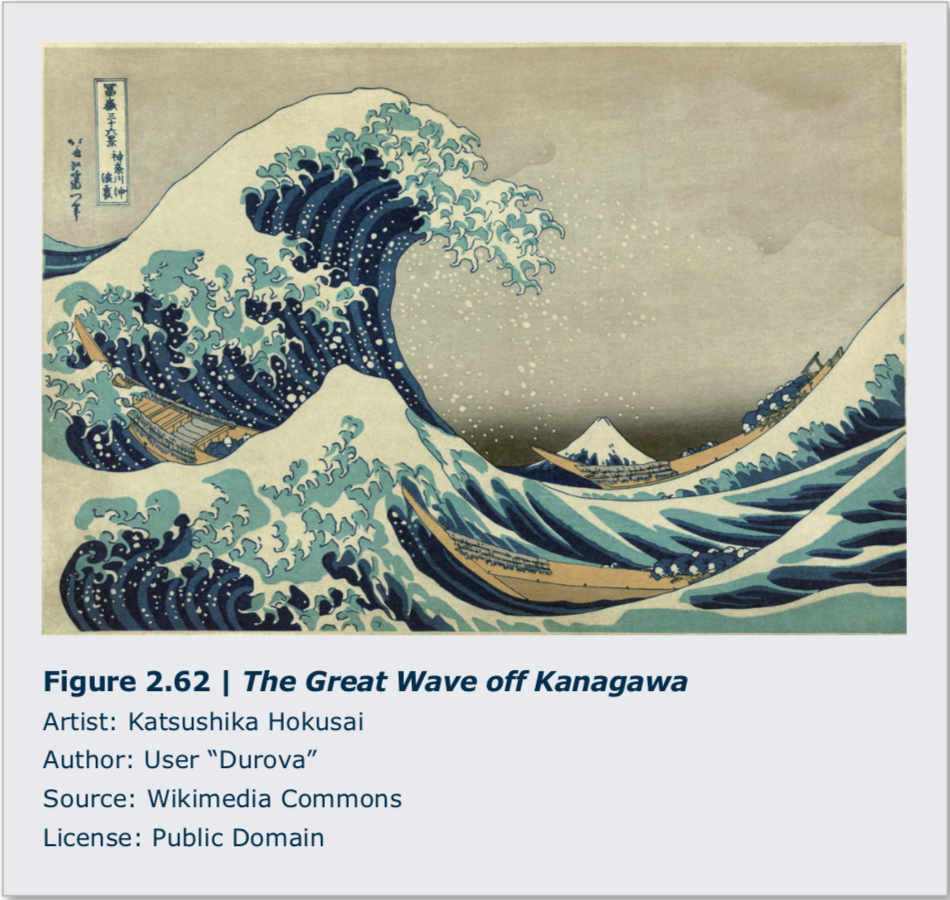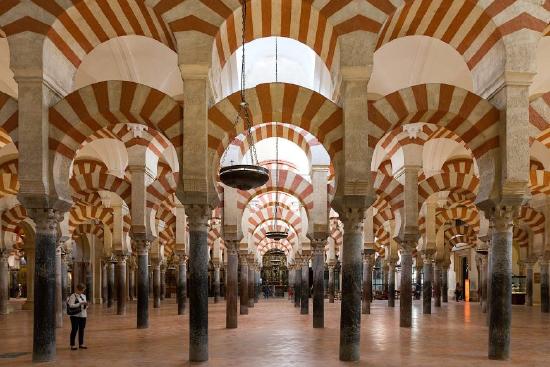3.1: Principles of Design- Rhythm and Pattern
- Page ID
- 156855
Overview:
The design principle of rhythm is the repetition of visual elements to establish a pattern. This pattern can then be used to provide a stage for a special object, or the pattern can be interrupted to direct attention to the change. In his commentary of mass consumer culture, Andy Warhol’s use of repetition compels us to notice the small differences between the apparently identical elements of his installation of paintings, 32 Campbell’s Soup Cans. (Figure 2.65)

What are Pattern and Rhythm?
Because the visual rhythm of the pattern is predictable, it often tends to unify an artwork. Pattern and rhythm bring order to space and create a dynamic experience of time. When a line, shape, color, or texture is repeated throughout a work of art, this is called either pattern or repetition. . Rhythm arises through the repetition of patterns. 1
Pattern
- The use of repetition of any elements such as line, color, texture, or shape through a work of art creates a pattern.
- The Blue Room is a painting by French artist Suzanne Valadon. She used strong colors and emphasized decorative backgrounds and patterned designs in this oil painting.
- There are three patterns; The blue bed cover is covered with leaves and stems, green and white striped pajamas, and a textured pattern of the back wall. 1

Suzanne Valadon, The Blue Room, 1923. Oil on canvas, 35½ × 45⅝". Musée National d’Art Moderne, Centre Georges Pompidou, Paris, France. "The Blue Room by Suzanne Valadon-1932" by mary holman is licensed under CC BY-NC-SA 2.0.
Rhythm
- Rhythm guides our eyes from one point to another in a work of art
- Rhythm is created when one or more elements of design are used repeatedly to create a feeling of organized movement.
- Artists create repetition by using the same shape, color, size, value, line, or texture over and over again
- In Katsushika Hokusai's The Great Wave, the use of repeating colors of different shades and tints of blue and white curvilinear shapes on the tips of waves creates rhythm. 1,5

- Rhythm gives structure to the experience of looking at an artwork. Some elements help our eyes to circle around the composition.
- In Pieter Bruegel's Hunters in the Snow, a group of people and the dogs on the left side of the painting is the starting point.
- Our attention follows the group’s direction, creating the first part of a rhythmic progression
- In the middle ground, figures appear to be ice skating
- The color of the sky and pond is almost the same color. They draw our attention to the horizon.
- The recession of the ridge-line pulls the eye to the left and into the far background
- We then naturally inspect details in the painting and notice subsidiary rhythms, such as the receding line of trees 1
![[ B ] Pieter Bruegel - Hunters in the Snow (1565)](https://human.libretexts.org/@api/deki/files/90732/5312935231_15461393cc_b.jpg?revision=1)
Pieter Bruegel, Hunters in the Snow, 1565. Oil on panel, 46 × 63¾". Kunsthistorisches Museum, Vienna, Austria. "[ B ] Pieter Bruegel - Hunters in the Snow (1565)" by Cea. is licensed under CC BY 2.0.
- Rhythm is the visual tempo set by repeating elements in a work of art or architecture.
- The arches and columns of the Great Mosque of Cordoba provide a good example.
- They are spaced very evenly, setting up an even tone to the building. This is then enlivened by the rhythm created by the striped pattern on the arches. 2

Hypostyle hall, Great Mosque at Cordoba, Spain, begun 786 and enlarged during the 9th and 10th centuries (photo: wsifrancis, CC BY-NC-ND 2.0)
- For contrast, we could look at Jackson Pollock’s Autumn Rhythm (# 30). Pollock was a fan of jazz music, and tried to capture something of its loose, syncopated rhythms.
- The resulting drip-paintings (they were made with the large canvases lying on the floor of his studio) have similarly loose, improvisational compositions.
- Despite its lack of formal structure, there is a clear rhythm running horizontally across the painting, and Pollock uses the title of the work to draw our attention to it. 2

Jackson Pollock, Autumn Rhythm (Number 30), 1950, enamel on canvas, 266.7 x 525.8 cm (The Metropolitan Museum of Art). "Autumn Rhythm" by gtrwndr87 is licensed under CC BY-SA 2.0.
Summary
- The design principle of rhythm is the repetition of visual elements to establish a pattern.
- Rhythm guides our eyes from one point to another in a work of art
- The visual rhythm of the pattern is predictable, it often tends to unify an artwork.
- Rhythm gives structure to the experience of looking at an artwork.
Sources
- Debra J. DeWitte, Ralph M. Larmann, and M. Kathryn Shields. Gateways to Art: Understanding the Visual Arts, Third Edition.
- Mittman, Dr. Asa. Pattern, repetition and rhythm, variety and unity. Khan Academy. https://www.khanacademy.org/humaniti...iety-and-unity
- Pace Gallery. Chuck Close. https://www.pacegallery.com/artists/chuck-close/
- Modern Art Museum. Chuck Close. Self-Portrait. www.moma.org/collection/works/79170
- The Metropolitan Museum of Art. https://www.metmuseum.org/art/collection/search/4543
- Pamela Sachant, Peggy Blood, Jeffery LeMieux, & Rita Tekippe

